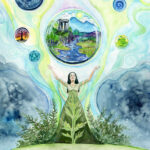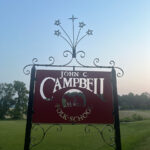Sankofa. This was the first principle taught to me during my Permaculture Teacher Training (from which I’ve just returned), by the incredible teacher Pandora Thomas. Sankofa is a word from the Twi language in Ghana that refers to the idea of it not being wrong to go back and find something that has been forgotten, or literally, “go back and get it.”

Sankofa, the art of finding again what has been lost.
Sankofa, the importance of understanding our past to live regeneratively in our present and shape our future.
Sankofa, the knowledge of the ancestors manifests today.
Sankofa deeply resonated within me as a druid and as a human being, someone trying hard to regenerate our lands and tread lightly upon the earth. When I look at the many movements that have touched me–of reskilling, sustainable living, natural building, community building, herbalism, permaculture, druidry–I see this principle woven into much of my current inspiration. For we are a people who have lost our path; we’ve lost the wisdom of our ancestors, of earth and water, seed and stone. Sankofa says that its ok, that we can go back and get it. Collectively, we can emerge from the fog of capitalism, consumerism, and industry to see that the tools and practices we need are still there, within us and found in our histories, waiting once again to come forth.
Sankofa, the act of finding our way again, with wisdom and guidance from the ancestors.
Sankofa, finding and renewing the ancient bonds between humans and the living earth.
Sankofa, a principle of living and being.
Sankofa certainly describes the work we do as druids following an earth-based spiritual path. Druid spirituality was inspired by the ancient druids and modeled, as much as we are now able, from their teachings and traditions. Druidry focuses on bringing us back to a closer relationship with the earth and rediscovering those ancient connections that humanity has always had, and still has, deep within. Druidry gives us old practices (nature observation, meditation, ritual, seasonal awareness) that are rekindled, and that help us reestablish that sacred relationship between humans and nature that had been forged over the millennia. Sankofa as a principle is fitting to describe part of what the druid tradition is about.

Likewise, Sankofa is an excellent fit to describe Permaculture. Permaculture is a system of principles and ethics, rooted in nature, that help us regenerate ecosystems and connections between ourselves, the land, and each other. Permaculture is rooted in the idea that we can live abundantly and richly while also improving the land and ecosystem around us, that we can be in partnership, working with nature, rather than against it. Permaculture design principles are not new; they are old principles with a new presentation fitting for today’s age. Humans through the centuries have understood–and enacted–these principles based on nature and tempered by common sense (observation, producing no waste, obtain a yield, value renewables, etc.). Before fossil fuels, these principles, implicit or explicit, were how humans lived and survived. But, for modern humans living in post-industrial times, these principles are new in the sense that we haven’t had these ways of knowing or stories shared with us in our upbringing, in our family traditions, in our educational system. The principles are no longer part of our cultural tradition or knowledge. Part of our response to the challenges of today that we collectively we face is, of course, remembering that the land is our greatest teachers, learning principles from that land, and enacting those principles again in our present reality. What we are discovering along the way is that this practice is not only necessary, it is fun, empowering, and meaningful work. Permaculture design is a new way of framing old knowledge.
One of the questions I’m often asked is why I practice permaculture, as part of my druidry, and why I work to integrate these two principles. What I have found through my interweaving of permaculture and druidry is this:
Permaculture aligns beautifully with an earth-honoring, earth-centered spiritual practice. Because permaculture focuses on designing from natures patterns, it helps better aligning us to the rhythms of the seasons, and regenerating landscapes intersects with spiritual and earth-centered seasonal celebrations, meditations, and studies. It gives me additional layers through which to understand my spiritual connection to the living earth.
Permaculture offers us tools for empowerment and change that are not culturally appropriated, tied to any person or belief. This is really important in a day and age where everything seems to be culturally appropriated or disconnected from its original context. These are universal principles, used all over the world, applied uniquely in different contexts, for regeneration.
Permaculture offers us hope. I get demoralized, as you’ll read from time to time on this blog, with what is going on beyond my control. As I think anyone who is awake and alive and paying attention now feels.
Permaculture is one outer practice to compliment the inner practice of druidry. The druid tradition gives me many tools for working on my own inner landscape and spiritually aligning with the living earth; permaculture gives me the tools to do the same on the outer landscape. As a druid and permaculture designer. I stand with my ancestors, those who understood the land and the patterns of the land, behind me, with me, weaving, and growing.

Last year, I wrote about the power of permaculture design as a way to regenerate the land, human-land, and human-human connections. I followed that post up with a discussion of my own five-year design site (which I moved away from last year to return to my homeland of Pennsylvania, land very much in need of regeneration). And I’ve done a smattering of posts on the topic: an introduction to the ethics of permaculture (which I’ll be returning to and expanding) and a post on the practice of self care from a druid/permaculture perspective and permaculture design sites and practices within permaculture (like sheet mulching). These posts wove between the inner and outer landscapes, offering suggestions and thoughts on how permaculture and druid practice can be intersected and connected. And while this entire blog has been, since its inception, dedicated to weaving between the inner and outer work of druidry as a sacred, regenerative practice and has been heavily inspired by permaculture design, I think I haven’t done the underlying principles of permaculture itself enough justice. So now, we are ready to dig into the design principles more explicitly and see how they can offer us some navigation and grounding in the time to come.
It is a good time to begin this series, as I have just returned from my permaculture teacher training course, with Pandora Thomas and Lisa Depiano, and feel empowered to write, grow, and learn with all of you! With the ancestors behind us, and the possibility of the future ahead of us, this post starts an extended series on “Permaculture for Druids” where I’ll weave principles from permaculture design with druid wisdom and explore permaculture’s place in both our inner and outer landscapes. Like my other series (Druid Tree Workings, Sacred Trees, and Land Healing), I’ll do this over a number of months with some other scattered posts on non-permaculture topics woven in between. Blessings!




Fantastic post. I had a similar idea of going back to get the past related to me by a close friend recently. I was lamenting the brokenness of my families ancestral lineage due to family issues and I was reminded that at the soul level the lineage is never broken. So that idea really resonates. Many thanks!
I think you are hitting the nail of the head. I’ve spent the better part of my life, prior to druidry, feeling like I had no ancestral traditions. My family has been in the US at least five generations, and quickly buried Irish, German heritage, etc. I also have a slight amount of Native American blood, and that too was eradicated. No cultural traditions are left. But the idea that those older ways of knowing, soul knowing, are still there somewhere, still present, and I can get the threads of them and bring them forth: it is very exciting! :). Nice to hear from you, Leeby!
I’ve been ruminating on this in terms of my Shamanic practice and came to the conclusion that a lack can turn into a strength. Because it can lead to a profound sense of inner rediscovery and inspired innovation. I got to understand my spiritual ancestry from the inside out, from spirit reaching out to me, instead of me working from a set of pre-concieved notions.
Thanks for your comment, Leeby! In permaculture, we’d say “the problem is the solution” :). A similar philosophy–the solution (sankofa) lies in the problem itself (the lack of cultural knowledge). I like this idea of “learning it from the inside out”; as though we are pulling it through our very spirits :).
Past, present, future it’s all stored in the Akashic fields, and our DNA is the key. I now understand why the ancients had such an oral and symbolic culture.
Reblogged this on Rattiesforeverworldpresscom.
Thank you for the reblog! 🙂
good post fun photos and art.
Thanks Papa Polypore! Hope you are finding good mushrooms 🙂
Always inspiring and timely! We are definitely on the same page with all of this. Congratulations on getting your Permaculture Teacher Training certification! I am sure you will be a wonderful, amazing teacher who brings so much to the table — from produce to wisdom to love to lore. Thank you for your tireless service to Mama Earth! ❤️
Thanks Laura! I hope you are well! The course was amazing–I was very honored to have been able to take it :).
BTW, have your Tarot of Trees decks come in yet? I know some people who would like them, myself included, but also some students and clients. 🙂
Yes! You can get them at http://www.tarotoftrees.com 🙂
I’m so excited you are going to write more on permaculture and Druidry! I have learning about permaculture for a few years now and eagerly look forward to the time I can afford to do a design course. This year I was able to attend the Wisconsin Permaculture Convergence which was fantastic. It was hosted at Kinstone this year, a site that features a mega stone circle. I learned so much there!
I want to write on it particularly because not everyone can afford a design course! Although I will draw your attention here: https://www.openpermaculture.com/
This is a free 72 hour design course for anyone :).
Hi Dana,
This is an interesting post. I wanted to tell you I was so inspired by your posts on retreats that I will be away at our Buddhist Hermitage here on Denman Island for the 14, 15 and 16 this month to do my first Druid retreat. I have been trying to do more and different meditations to prepare for the retreat. This evening while I was meditating in the garden, two night hawks flew over the clearing. I was out at just the right time as I have never seen them here before. So I am feeling blessed by your teachings.
Yours under the red cedar,
Max Rogers
Hi Max,
I’m so glad to hear you are going on retreats! Do let me know how it goes for you :). The hawks sound like a wonderful sign!